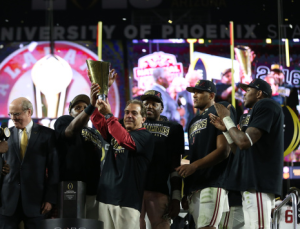
Alabama coach Nick Saban hoists the college championship trophy. Photo by Kent Gidley / University of Alabama
While the number didn’t set a stadium record — the 6.23 TB of Wi-Fi used at Super Bowl XLIX last February in the same venue is still the highest single-game Wi-Fi mark we’ve seen — the 4.9 TB used Monday nearly matches the total from last year’s inaugural College Football Playoff championship game at AT&T Stadium in Arlington, Texas, where 4.93 TB of Wi-Fi was used. It’s worth noting, however, that Monday night’s game had 75,765 fans in attendance, almost 10,000 less than last year’s crowd of 85,689 at the first playoff championship. So at the very least, Monday’s fans used more data per fan in attendance than last year’s game.
On the cellular side of things however, AT&T reported that data usage on its DAS network Monday night exceeded the total from last year’s Super Bowl, with 1.9 TB carried Monday to top the 1.7 TB total AT&T recorded at Super Bowl XLIX. UPDATE, 1/26/16: Verizon has followed up with a report claiming it had 2 TB of DAS traffic at the event. So for right now the wireless total from Monday’s game stands at 8.8 TB, a number that still might grow if we ever hear from Sprint or T-Mobile.
Mark Feller, vice president of information technology for the Arizona Cardinals, said that the University of Phoenix Stadium Wi-Fi network saw 23,306 unique devices connect Monday night, with a peak concurrent connected total of 17,297 devices. The stadium network also saw an additional 1.2 TB of wired data used Monday night, primarily from press and photographer Ethernet connections, Feller said.
The 4.9 TB mark unofficially puts Monday’s game in the “top four” of highest-ever single game Wi-Fi data totals we’ve seen, behind only last year’s Super Bowl, an Alabama game at Texas A&M’s Kyle Field this fall that hit 5.7 TB, and (barely) last year’s college championship game. All eyes in the Wi-Fi totals world now turn to Levi’s Stadium, where Super Bowl 50 takes place Feb. 7. Will the 6.2 TB mark survive, maybe showing that fan data use at big games has peaked? Or will a new record be set?






